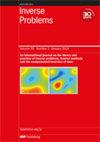基于高斯尺度混合物的贝叶斯反演与学生 t 先验
IF 2.1
2区 数学
Q1 MATHEMATICS, APPLIED
引用次数: 0
摘要
许多逆问题的重点是恢复一个先验已知表现出不连续或平滑行为的相关量。在逆问题的贝叶斯方法中,这种结构信息可以用马尔可夫随机场先验来编码。我们提出了一类将马尔可夫随机场结构与 Student's t 分布相结合的先验。这种方法可以根据可用数据,灵活地模拟各种结构行为。灵活性是通过在贝叶斯逆问题的表述中加入 Student's t 分布的自由度参数来实现的。为了方便后验计算,我们采用了高斯尺度混合表示法来表示 Student's t 马尔科夫随机场先验,这样就可以根据辅助超参数将先验表达为条件高斯分布。采用这种表示方法,我们可以以封闭形式推导出大部分后验条件分布,并利用吉布斯采样器探索后验。我们用两个数值示例来说明该方法:信号解卷积和图像去模糊。本文章由计算机程序翻译,如有差异,请以英文原文为准。
Bayesian inversion with Student’s t priors based on Gaussian scale mixtures
Many inverse problems focus on recovering a quantity of interest that is a priori known to exhibit either discontinuous or smooth behavior. Within the Bayesian approach to inverse problems, such structural information can be encoded using Markov random field priors. We propose a class of priors that combine Markov random field structure with Student’s t distribution. This approach offers flexibility in modeling diverse structural behaviors depending on available data. Flexibility is achieved by including the degrees of freedom parameter of Student’s t distribution in the formulation of the Bayesian inverse problem. To facilitate posterior computations, we employ Gaussian scale mixture representation for the Student’s t Markov random field prior, which allows expressing the prior as a conditionally Gaussian distribution depending on auxiliary hyperparameters. Adopting this representation, we can derive most of the posterior conditional distributions in a closed form and utilize the Gibbs sampler to explore the posterior. We illustrate the method with two numerical examples: signal deconvolution and image deblurring.
求助全文
通过发布文献求助,成功后即可免费获取论文全文。
去求助
来源期刊

Inverse Problems
数学-物理:数学物理
CiteScore
4.40
自引率
14.30%
发文量
115
审稿时长
2.3 months
期刊介绍:
An interdisciplinary journal combining mathematical and experimental papers on inverse problems with theoretical, numerical and practical approaches to their solution.
As well as applied mathematicians, physical scientists and engineers, the readership includes those working in geophysics, radar, optics, biology, acoustics, communication theory, signal processing and imaging, among others.
The emphasis is on publishing original contributions to methods of solving mathematical, physical and applied problems. To be publishable in this journal, papers must meet the highest standards of scientific quality, contain significant and original new science and should present substantial advancement in the field. Due to the broad scope of the journal, we require that authors provide sufficient introductory material to appeal to the wide readership and that articles which are not explicitly applied include a discussion of possible applications.
 求助内容:
求助内容: 应助结果提醒方式:
应助结果提醒方式:


